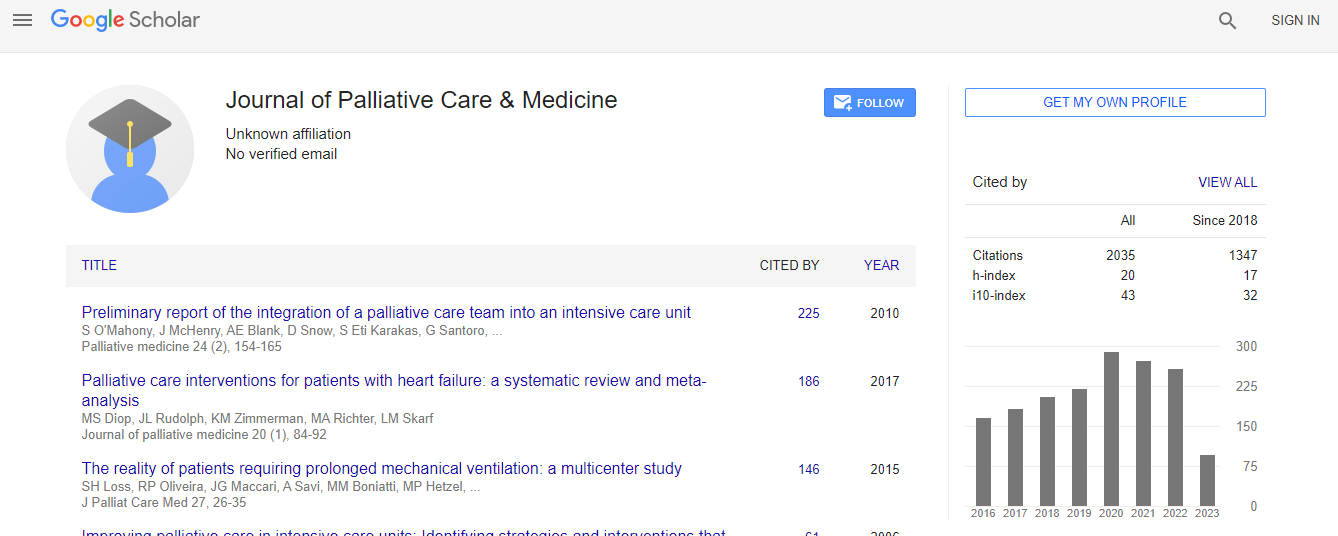Our Group organises 3000+ Global Conferenceseries Events every year across USA, Europe & Asia with support from 1000 more scientific Societies and Publishes 700+ Open Access Journals which contains over 50000 eminent personalities, reputed scientists as editorial board members.
Open Access Journals gaining more Readers and Citations
700 Journals and 15,000,000 Readers Each Journal is getting 25,000+ Readers
Recommended Conferences
42nd Global Conference on Nursing Care & Patient Safety
Toronto, CanadaGoogle Scholar citation report
Citations : 2035
Journal of Palliative Care & Medicine received 2035 citations as per Google Scholar report
Journal of Palliative Care & Medicine peer review process verified at publons
Indexed In
- Index Copernicus
- Google Scholar
- Open J Gate
- Genamics JournalSeek
- China National Knowledge Infrastructure (CNKI)
- Electronic Journals Library
- RefSeek
- Hamdard University
- EBSCO A-Z
- OCLC- WorldCat
- Virtual Library of Biology (vifabio)
- Publons
- Geneva Foundation for Medical Education and Research
- Euro Pub
- ICMJE
Useful Links
Recommended Journals
Related Subjects
Share This Page
Diverse and unique end of life practices in a Buddhist patient in Singapore
5th World Congress on Hospice and Palliative Care
Pushparanee Somasundram
Sengkang General Hospital, Singapore
Keynote: J Palliat Care Med
Abstract
Mr C had terminal cancer of the colon. He was keen to have Tibetan Buddhist rituals and prayers prior to and after his death so he can have a good rebirth. This entailed was no touching of the body for 8 hours after the last breath leaves his body for the soul to leave peacefully. Tibetan Buddhists believe the soul is still around in the body until 8 hours after death. The dilemma for the health care worker was how to pronounce time of death of the patient. A win compromise was achieved after health care workers discussed and analyzed the inputs from the family and the monks. The ECG monitor was set up before the 8 hours period. This allowed the health care worker and the monks to know when death (asystole) occurred. Just before his demise, Monks performed rituals and holy chants. Relatives refrained from crying as it may hinder a happy rebirth. They also placed holy garments on the patient before death, placing Buddhist pictures and their meditation beads in his hands. The healthcare worker could still do the monitoring and pronounce the time of death. The monks could do the prayers for the departing soul. The family is happy the loved ones managed to have a peaceful death. Clinical importance of understanding the cultural and psychosocial aspects of patient care ensures there are no glitches in bereavement process for the grief-stricken family.Biography
Pushparanee Somasundram is the Senior Staff Registrar in the Department of Family Medicine in Sengkang General Hospital, Singapore. Her research and care focus are on older people and end of life care. She serves on many professional committees and advisory boards.
E-mail: psomasundram@yahoo.com

 Spanish
Spanish  Chinese
Chinese  Russian
Russian  German
German  French
French  Japanese
Japanese  Portuguese
Portuguese  Hindi
Hindi 
